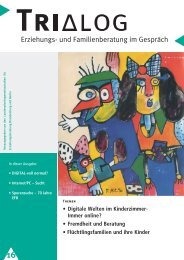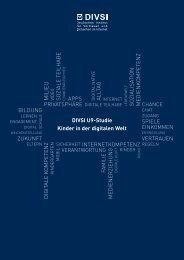ora-schriften-s-2013
ora-schriften-s-2013
ora-schriften-s-2013
Create successful ePaper yourself
Turn your PDF publications into a flip-book with our unique Google optimized e-Paper software.
Prof. Dr.-Ing. habil. Ulrike Lucke<br />
Up to now, the description of algorithms to<br />
analyze textual or visual content elements<br />
was rather vague. The next section provides<br />
in introduction to technical possibilities for<br />
this analysis.<br />
4. Which mechanisms can we use<br />
for detection?<br />
The benefits of such a solution are that<br />
every decision (in our case: on approval or<br />
rejection of a message to be classified as<br />
suspicious or not) can be justified in terms<br />
of the rules that have been applied.<br />
Moreover, there is experience from several<br />
application fields that are dealing with rulebased<br />
systems for several years.<br />
For the field of<br />
Cyber-Grooming,<br />
extensive<br />
empirical studies<br />
will be necessary<br />
in order to make<br />
pattern of<br />
offenders and<br />
victims explicit,<br />
before automated<br />
detection<br />
based on such<br />
rules can be<br />
applied.<br />
The description of image analysis revealed<br />
that a tradeoff between performance and<br />
accuracy of detection algorithms may<br />
become necessary, given the limited time<br />
for analyzing and rating messages in a<br />
stream. Moreover, technology asks for<br />
another tradeoff between accuracy and<br />
transparency, since transparent detection<br />
algorithms (i.e. those who come along with<br />
a reason for their rating) tend to be rather<br />
error-prone, and vice-versa. The next two<br />
sections present relevant approaches at<br />
either ends of this scale, followed by a third<br />
section describing a system architecture<br />
that integrates such algorithms and tools<br />
into a complete framework.<br />
4.1 Rule sets<br />
Rule-based systems are a well-studied<br />
approach to make knowledge of human<br />
experts explicit and interpretable by<br />
automated processing. Such an expert<br />
system defines a set of conditions on how<br />
to handle incoming data [12]. For this<br />
purpose, it consists of two kinds of machinereadable<br />
information:<br />
●●<br />
A knowledge base contains a set of<br />
information that was proven to be<br />
true.<br />
●●<br />
An interference engine describes a<br />
set of operations how this knowledge<br />
as well as incoming data can be<br />
transformed.<br />
The expert system tries to infer new<br />
statements from this basis, with the final<br />
goal to conclude with a statement on<br />
approval or rejection of the message to be<br />
classified.<br />
However, there are some weak points. First<br />
of all, the success of this approach depends<br />
on the precision and completeness of given<br />
rules. This requires explicit modeling of<br />
knowledge in the respective field, which is a<br />
challenge where empirical data is still<br />
missing or not yet valid enough. For the<br />
field of Cyber-Grooming, extensive<br />
empirical studies will be necessary in order<br />
to make pattern of offenders and victims<br />
explicit, before automated detection based<br />
on such rules can be applied. Finally,<br />
complex rule sets make high demands on<br />
processing power. Current research on<br />
answer set programming [11] will help to<br />
tackle this problem.<br />
These pro’s and con’s make rule-based<br />
systems more appropriate for textual<br />
analysis in the detection process described<br />
above.<br />
4.2 Artificial neural networks<br />
At the contrasting end of the scale, a wellknown<br />
computational approach inspired by<br />
nature is available. Artificial neural networks<br />
imitate the structure and behavior of a brain<br />
in order to make a decision [2]. A number of<br />
switching elements (neurons) are arranged<br />
in a multi-layered architecture. They are<br />
connected with some preceding and<br />
subsequent switches following a given<br />
topology. Each connection is associated<br />
with a certain weight in order to strengthen<br />
or weaken the transmitted signal. Moreover,<br />
every switch has its own scheme to derive<br />
an output signal from the set of incoming<br />
signals. The overall output is calculated by<br />
the switches in the last layer. A network<br />
functions as follows:<br />
78 Special Edition <strong>2013</strong>





